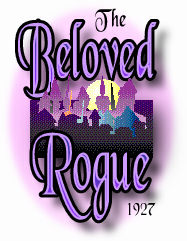

United Artists
Cast: John Barrymore (Francois Villon), Marceline Day (Charlotte of Vauxcelles), Conrad Veidt (King Louis XI), Lawson Butt (Duke of Burgundy), Henry Victor (Count Thibault), Slim Summerville (Jehan), Mack Swain (Nicholas), Dick Sutherland (Tristan L'Hermite, the King's Executioner)
Francois Villon was born after his father was burned at the stake fighting for France. In his adulthood, he becomes Paris' first poet and is passionately devoted to France, however he associates with the downtrodden and less fortunate denizens of the city. The Duke of Burgundy seeks to become King of France through subterfuge. Because the superstitious King Louis XI is advised by his astrologer that war with the Duke would be disastrous to France, he dares not defy the Duke. So, when the Duke asks that the King give his ward, Charlotte of Vauxcelles, to his cousin, Count Thibault, in marriage, the King accedes in spite of Charlotte's protestations. On All Fool's Day, Villon is crowned King of Fools, and when the Duke arrives to break up the revelry, Villon insults him. The King, afraid to offend the Duke, banishes Villon from Paris. Later, Villon and some of his friends steal a wagon of food being delivered from the Duke to the King. They use the King's catapult to send the food flying into the streets of Paris for the poor. However, Villon is accidentally catapulted by the contraption through a window and into the room of an inn where Charlotte is staying as she and the Count await a snowstorm on their way to their wedding. After a chase and fight in which Villon accidentally defeats the Count, Charlotte's admiration for Villon's poetry entices her to run away with him. Eventually, Villon is captured, and Charlotte returns to get ready for her marriage. Villon is taken to Burgundy, tortured and put on display in a cage just prior to the wedding ceremony. Surprisingly, it is the King's barber who convinces him that the marriage is the first step in the Duke's plan to take over the throne. It is up to the King to rescue Villon and Charlotte.
Buster Keaton's masterpiece "The General" (1927) is a prime example of a great film that, for some odd reason, didn't get its just due at the time of release. Although John Barrymore's "The Beloved Rogue" (1927) is not on a par with "The General," it is nonetheless a better film than its reception in 1927 indicated.
According to James Card (Seductive Cinema,
Alfred A. Knopf, 1994), "The entire picture, in fact, was
far from the track that 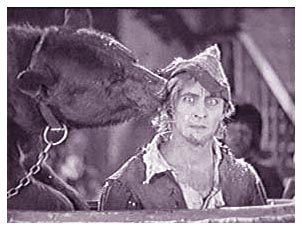 Hollywood was successfully
beating, and the Fairbanksian style heartily adopted by Barrymore
was so unexpected by his fans and so unanimously condemned by
the critics that the film did not do well financially." It
is also strange to note that Barrymore himself did not like the
film. In Damned in Paradise: The Life of John Barrymore
(Atheneum, 1977), biographer John Kobler said the finished film
was "a far cry from what John had envisioned" and went
so far as to say Barrymore "loathed" it. Kobler claims
Barrymore stole into the balcony of one of the first public screenings
of "The Beloved Rogue." After watching the film for
some time, "unable to contain himself any longer, he startled
the audience by shouting, 'Call yourself an actor? My God, what
a ham!'"
Hollywood was successfully
beating, and the Fairbanksian style heartily adopted by Barrymore
was so unexpected by his fans and so unanimously condemned by
the critics that the film did not do well financially." It
is also strange to note that Barrymore himself did not like the
film. In Damned in Paradise: The Life of John Barrymore
(Atheneum, 1977), biographer John Kobler said the finished film
was "a far cry from what John had envisioned" and went
so far as to say Barrymore "loathed" it. Kobler claims
Barrymore stole into the balcony of one of the first public screenings
of "The Beloved Rogue." After watching the film for
some time, "unable to contain himself any longer, he startled
the audience by shouting, 'Call yourself an actor? My God, what
a ham!'"
Despite all this, "The Beloved Rogue" is an uplifting, fast-paced story that doesn't get bogged down at any time during its 99-minute run and provides a splendid mix of drama and humor. Barrymore has received his share of criticism for the "Fairbanksian style" critics claim he adopted for the movie. Although there may be some shades of Doug in the performance, the part demands it, and Barrymore shouldn't be denigrated for the way he interpreted the carefree scoundrel Francois Villon.
Upon first considering the role of Francois Villon, Barrymore wrote, "I now wish for this new firm I am with (referring to his recent signing with United Artists) to do something totally different that I have greater sympathy with, and can get much more fun out of, and I believe achieve a more significant result, and that is with the extraordinary figure of Villon as a vehicle to rather burlesque the whole idea of romance." It appears Barrymore achieved exactly what he set out to do -- have some "fun" with the character and "burlesque" the romance aspect. Many fans were disappointed they didn't see the Barrymore they were accustomed to dashing, romantic, making passionate, elegant love. They didn't want to see Barrymore "burlesque" romance.
Critics such as Mordaunt Hall in The New York Times obviously didn't agree with Barrymore's "take" on the character. "Others, who may anticipate a cross between Robert Louis Stevenson's study of the vagabond poet and the romantic figure painted by Justin Huntly McCarthy in 'If I Were King,' will be disappointed, for this current film release, now at the Mark Strand, is a fanciful affair which has none of the clever and impressive situations that marked Mr. McCarthy's masterpiece. . . . It is obvious in 'The Beloved Rogue,' which comes to the screen from Paul Bern's pen, every effort has been made to dodge Mr. McCarthy's novel and play."
That may well be, and it is also safe to assume that Barrymore didn't see the cinematic value in a literal transition of McCarthy's tale to the screen. The end result, that is, Barrymore's interpretation, is nevertheless exceedingly entertaining.
The story takes place in 15th century France, and we are immediately introduced to the story's main conflict -- protecting the throne from the ambitious and power-hungry Duke of Burgundy, the antagonist in our story. Titles tell us, "Burgundy seeks to enslave France -- by craft -- not by war. Charles, Duke of Burgundy, covets the throne of France." We are also introduced to the King of France, who, rather than being a stalwart figure such as England's Richard the Lion-Hearted, is, instead, a stoop-shouldered, weak-minded leader. A title describes him as "superstitious, crafty, cruel -- a slave of the stars." Rather than his own wisdom, King Louis XI relies on the advice of his astrologer to rule his country.
Enter Francois Villon, described as a "poet,
pickpocket, patriot -- loving France earnestly, Frenchwomen excessively,
French wine exclusively." Our introduction to Villon comes
by way of an event, All Fool's Day, in which he has been chosen
King of Fools. The revelers, made up of Paris' less fortunate,
have selected him for this honor and are shown dancing through
the streets and calling for him. Once found, Villon graciously
accepts the title and allows the revelers to make him up as a
clown. He is then placed upon a statue of a horse in the courtyard.
However, the revelry is hushed when Charles, Duke of Burgundy,
arrives with his henchmen to quell the merriment. Villon is well
aware of Charles' reputation and insults the Duke. The King then
arrives and learns of Villon's impudence. 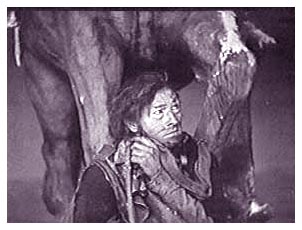 Because his astrologer has advised him to remain friendly with
Charles, the King banishes Villon from Paris.
Because his astrologer has advised him to remain friendly with
Charles, the King banishes Villon from Paris.
Up to this point, the film has portrayed Villon as a clown, a buffoon whom we certainly don't see as a threat to the Duke, much less a savior of France. But Barrymore's performance turns serious. The crowd disperses, and Villon falls to his knees, distraught at the banishment, indeed, just as if death were imminent. Card described this moment well. He noted that in Barrymore's films, ". . . there was never a portrayal without at least a moment worth more than the price of admission. In some, he achieved sequences absolutely ineradicable from memory -- the scene in 'The Beloved Rogue,' with Villon as King of Fools in traditional clown makeup, learning of his banishment from Paris. Only in his stricken eyes can one see the bitter pain of such punishment, and as he slowly removes the clown makeup, his face becomes ever more grotesque and ever more a mask of the most acute suffering."
Barrymore's performance continues to intrigue the viewer throughout the film. He is given the opportunity to make love to the ever-charming Marceline Day, as the King's ward, Charlotte of Vauxcelles, who is at first enthralled by Villon's poetry, then his daring as he rescues her from Charles' cousin, Count Thibault, to whom the king has given her to marry. A beautiful scene takes place later in the garden of the palace after Villon has won the King's favor and has bathed and donned new clothes. Villon professes his love to Charlotte, falling to a knee and kissing her hand. However, he is hurt deeply when she tells him that "Charlotte of Vauxcelles may not marry a man without lands and a great name." Barrymore excellently portrays the range of emotions here.
Later in the film, he is the captive of Charles and Count Thibault. The scenes of Villon being tied up and tortured with fire, then placed in a small cage and hung outside Charlotte's window are emotionally charged and effective.
Surprisingly, most critics were not impressed
by Barrymore's performance. The New York Times reviewer
gave lackluster  praise when he said,
"Mr. Barrymore's performance is just as good as his work
in 'When a Man Loves' and 'Don Juan'." Photoplay simply
said, "John Barrymore is in this picture."
praise when he said,
"Mr. Barrymore's performance is just as good as his work
in 'When a Man Loves' and 'Don Juan'." Photoplay simply
said, "John Barrymore is in this picture."
Conrad Veidt, however, received good words for his portrayal of King Louis XI. Picture Play said, "Conrad Veidt, the German actor, gives the only convincing characterization in the picture as the king." The New York Times reviewer said Veidt gave a "sound performance," but he preferred Fritz Lieber's characterization in a 1920 version of the story. Motion Picture World said, "Conrad Veidt gives a convincing and excellent characterization of he crafty, superstitious monarch. . . "
According to Veidt biographer John T. Soister
(Veidt on Screen, McFarland & Company, Inc., 2002),
Veidt was personally selected by Barrymore for the role of King
Louis XI, and Barrymore sent the German actor a telegram stating
that he couldn't make the picture without him. At first reluctant,
Veidt was convinced by a second telegram to leave a successful
career in Germany and try Hollywood. Soister went on to explain
that United Artists executives were surprised when they learned
Veidt was six foot three, while historians claim that Louis was
"short and squat." According to Soister, "UA came
to the painful conclusion that Veidt would conceal his stature
in long, full robes and walk in a stooped fashion."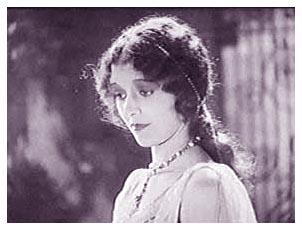
The presence of Marceline Day is also welcome in any film, and she adds great beauty, if not any great exercises in acting, to the movie. Day is called upon more than once to express fear, and her large dark eyes are perfect as she recoils, wide-eyed, from some threat. A very charming scene takes place when Villon has rescued Charlotte from Count Thibault and scurries across the snow-capped rooftops to his mother's home. Villon slides down one of the rooftops straight through an open window of his mother's home. He then encourages Charlotte to do the same, but she sits at the crest of the snow covered roof and shakes her head fearfully while looking for another means of escape. Villon urges, "Slide, gentle lady slide -- and I will catch you -- without catching a glimpse." She reluctantly agrees and slides right into his arms."
A delightful addition to the film is the
presence of Mack Swain and Slim Summerville, two veteran comedians
who endeared themselves to audiences back in the early Keystone
Cops days. Surprisingly, though, they are not used for "comic
relief," per se, but give fairly straightforward performances
as Villon's loyal cohorts, Jehan and Nicholas. Actually, rather
than "comedy," it seems much more appropriate to describe
this film's offering as "humor," a somewhat more delicate
word, and virtually all of that belongs to Barrymore. Swain and
Summerville provide 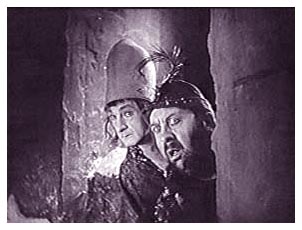 humor only in conjunction
with Barrymore's antics.
humor only in conjunction
with Barrymore's antics.
Angelo Rossitto, as the dwarf named Beppo, has been included in the story solely to add humor, though. In one scene, the King's executioner, portrayed superbly by the less than pleasing-looking Dick Sutherland, is appointed to watch over Villon and protect him. To that end, he allows Villon only one glass of wine. When Beppo learns of this, he decides to take charge, walks up to the giant, and threatens, "Give Francois all the wine he wants -- or I'll bring my little brother over to thrash you!"
The scene where Villon, Jehan and Nicholas are using the King's catapult to send food into the streets of the city is one of the most amusing in the film. The vision of Villon accidentally being catapulted through a window and into Charlotte's room is also one of the most memorable in silent cinema.
It should also be noted that excellent performances are given by Lawson Butt as the Duke of Burgundy and Henry Victor as Count Thibault, both adequately menacing and eliciting the necessary disgust from the viewer.
Needless to say, the characters and the portrayals by this excellent assemblage of actors is appropriate and convincing. The performances are coupled with an exciting story line, as well, that gives us characters to hate, those to love, and those to amuse us. All the elements of a good story are there, and the viewer is mesmerized throughout and not bored at any time.
No mention of "The Beloved Rogue" can be made with praising the sets. According to Card, " . . . the real star of the production was William Cameron Menzies, designer of the fantastic settings for this film that never again found their counterpart in American cinema. Like the whole approach to the film, the sets are imaginatively grotesque." The importance of Menzies' sets to the enjoyment of this film can't be underestimated. There is a period feel to the scenes without being tied to a certain period. The poverty of the people is evident in the sets without being shockingly realistic. The sharp, arched snow covered roofs of the city give the feel of an artistic, almost impressionistic, painting, and the tints and tones especially the soft blues -- add to that feel. Much of the action takes places at night, as well, and there is a softness about these scenes. Even the day scenes do not have harsh light, but are, instead, somewhat subdued as one would expect on a late winter's day.
Director Alan Crosland also deserves credit. In a film in which much of the action takes place on rooftops, camera angles are important, and the sense of danger and height is there. Again, the pacing of the film is rapid and absorbing, and, for this, credit it also due.
The print reviewed is the Paul Killiam version which is excellent quality, although very slightly dark at times. Tints and tones are beautiful and add immensely to the visual enjoyment. "The Beloved Rogue" was one of William Perry's favorite films to play for, and his piano score for this film is superb, as usual.
One final note, the only surviving print of the "The Beloved Rogue" was found in John Barrymore's former mansion by its then current occupant, Edgar Bergen, who donated it to the American Film Institute. It was subsequently preserved by the Library of Congress.